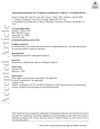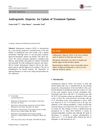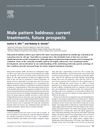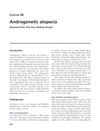My Shedding Never Stops on Medication 23M Progress Pictures 6/9/2025
A 23-year-old male experienced initial success with finasteride, topical minoxidil, and ketoconazole for hair loss, but persistent shedding and scalp issues led him to switch to dutasteride without improvement. Users suggest stress management, addressing potential seborrheic dermatitis, and patience with the treatment process.
View this post in the Community →
Similar Community Posts Join
5 / 1000+ resultscommunity Taking Charge of Your Hair: The "Big 3 Stack" Explained for 2023
The "Big 3 Stack" for hair loss treatment, which includes Minoxidil for hair density improvement, Ketoconazole shampoo for enhancing hair volume and thickness, and Finasteride for blocking hair loss causing hormones. Microneedling can boost Minoxidil's effects.
community DHT Harms Scalp Microbiome: DHT Itch is REAL
Increased Malassezia and Cutibacterium in the scalp microbiome are linked to higher sebum production and inflammation in androgenetic alopecia (AGA). Treatments include ciclopirox shampoo, benzoyl peroxide shampoo, clobetasol propionate, calcipotriol, minoxidil, finasteride, and dutasteride.
community Ultimate Hairloss Flowchart (for beginners)
The conversation discusses a hair loss flowchart for beginners, with mixed opinions on its effectiveness. Treatments mentioned include minoxidil, finasteride, dutasteride, microneedling, and vitamins.
community Minox. 2.5 percent, Finasteride 1.25mg, Microneedling 1.5 mm, Ketoconazole shampoo and Biotin. Got better until it didn’t. Should I start dutasteride and Ru?
User experiencing hair loss tried Minoxidil, Finasteride, Microneedling, Ketoconazole shampoo, and Biotin. Others suggest continuing current treatment for 1-2 years before considering Dutasteride and RU58841.
community Topical Dutasteride Progress (2.5 months)
A 21-year-old male is using a topical treatment for hair loss, including Dutasteride, Minoxidil, Tretinoin, Ketoconazole, and Hydrocortisone, along with derma rolling. He reports no side effects from the treatment and seeks feedback on its effectiveness for hair regrowth.
Related Research
6 / 1000+ results
research Topical Ketoconazole for the Treatment of Androgenetic Alopecia: A Systematic Review
Ketoconazole may help regrow hair and increase follicle size, but more research needed.

research Androgenetic Alopecia: An Update Of Treatment Options
Minoxidil is the only FDA-approved topical drug for treating male or female pattern hair loss, and other medications like finasteride and dutasteride can also increase hair growth.

research Male Pattern Baldness: Current Treatments, Future Prospects
Current treatments for male pattern baldness include minoxidil and finasteride, with new options being developed.

research Overactive Bladder in Men: Finasteride for Androgenetic Alopecia
Finasteride increases hair count and improves hair growth with low risk of side effects.
research Male Androgenetic Alopecia
Male pattern baldness worsens with age and can be treated with medications like minoxidil and finasteride, but side effects and personalized care are important.

research A Randomized, Double-Blind, Placebo and Active Controlled Phase II Study to Evaluate the Safety and Efficacy of Novel Dutasteride Topical Solution (0.01%, 0.02%, and 0.05% w/v) in Male Subjects With Androgenetic Alopecia
The 0.05% dutasteride topical solution effectively promotes hair growth with fewer side effects than oral treatments.